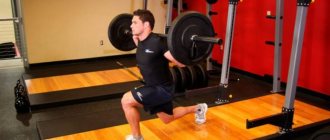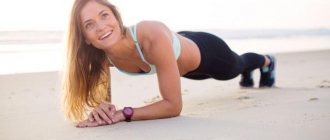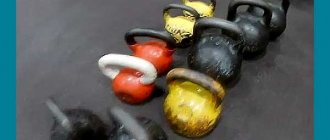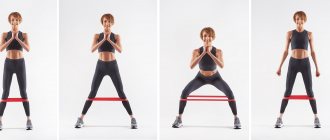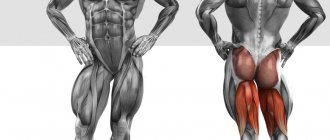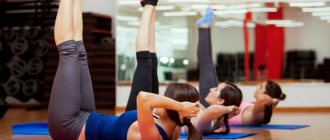Why you can't swim with your head up
The first and most important thing we would like to start this article with is: regularly swimming with your head up is harmful!
Swimming with your head up can be considered acceptable in two cases:
- You swim on vacation and spend time in the water for pleasure, not for sport, you do not have the task of swimming any distance. In this case, it is quite permissible to stay in the water with your head raised, if we are not talking about long swims. But just keep in mind that this is purely recreation; this has nothing to do with proper swimming.
- You are forced into a situation where you need to swim somewhere, but you don’t have swimming goggles with you and you don’t know how to swim with your eyes open underwater - but you need to watch where you are swimming . In this case, there is no other option but to raise the neck.
In all other cases, regular exercise with your head up does not benefit your body, but harm :
- In this position, the cervical spine is overloaded .
For a better understanding, imagine that you sit or stand with your head thrown back all the time. This position is not physiological and is extremely uncomfortable for the body. And if you lie on your chest with your head thrown back, then this is even worse - instead of relaxation, there is an increased load on the cervical spine, which can lead to the development or aggravation of diseases of the cervical spine. - Compression of the blood vessels occurs - narrowing of the vertebral arteries, and blood supply to the head deteriorates .
- In addition to the cervical region, the body itself is in an incorrect position: it is not elongated, but, on the contrary, there is a bend in the rest of the spine , and there is an incorrect load on it.
- The main principle of swimming is violated: there is no sliding . The longer and more elongated any object is, the better it glides through the water surface. A raised neck disrupts the elongated line of the body and instead of the body sliding, it only begins to slow down because of it. In this case, you can forget about fast movement.
Consult a neurologist and orthopedist about why it is harmful to swim with your head raised, and whether you have any contraindications to swimming in the pool.
From the above, the main rule follows: swim only with your head in the water .
This, however, may seem uncomfortable from the point of view of inconvenience of breathing, we will talk about this in the next section.
Can pregnant women walk a lot if they have varicose veins?
While waiting for a baby, the load on a woman’s body increases. The changes in the functioning of the respiratory and cardiovascular systems are especially noticeable. To improve your well-being and prepare your body for childbirth, as well as further recovery, you should remain physically active during pregnancy.
Walking is the most natural and safe form of physical activity for an expectant mother.
- Walking has a good cardiac stimulating effect and prevents a large number of pathological conditions, for example, varicose veins and edema.
- When walking, the abdominal muscles are strengthened, which contributes to a successful pregnancy and successful childbirth.
To ensure that walking only brings benefits, you should follow some recommendations from doctors:
- Start walking at a slow pace for short distances.
- Watch your posture - straighten your back and do not strain your shoulder girdle.
- Smoothly lower your foot onto your heel and push off with your toe.
- Choose a walking route away from highways and noisy streets.
- Monitor your condition. If you feel tired, it is better to take a break to rest.
- After your walk, you can take a relaxing foot bath or lie down with a pillow or folded blanket under your feet. Such procedures will improve venous blood flow and avoid swelling.
Walking should be avoided in the following cases:
- With increased uterine tone.
- Exacerbation of chronic or acute diseases.
- Threat of miscarriage.
- Severe toxicosis.
If pain or tingling occurs when walking, it is better to stop exercising for a while or move only at a slow pace.
Walking is a simple and beneficial exercise for pregnant women
How to breathe?
The need to breathe is perhaps the main reason that makes people swim incorrectly. However, in reality, breathing with your head lowered into the water can be mastered in just a couple of lessons.
The moment of entering the water in the crawl
The basis of breathing is exhaling with your face down . Exhale into the water through your nose or mouth. This is the first thing that pool coaches begin to teach children.
It’s quite simple to master exhaling into water:
- At the beginning of the lesson, stand at the edge of the pool. Holding it with your hands, lower your face into the water and exhale (trainers tell children to “blow bubbles with their nose”).
- Pick up a swimming board and swim with your face in the water. The board will support your body; swim using your legs. Place your face in the water and exhale slowly, raising your head to inhale. As is correct, after only 5-10 lanes of swimming in the pool in this way, exhaling into the water ceases to bring any discomfort.
You will inhale either when turning your head to the side (when swimming crawl) or when lifting it (when breaststroke).
You will quickly realize that breathing into the water is not something difficult - something that would be worth harming the cervical spine by swimming with a constantly tense neck.
For more information on how to breathe while swimming, read this article.
Physics. Floating bodies and conditions for floating bodies
Sailing conditions
The conditions for floating bodies follow from Archimedes' law:
The immersion depth of a floating body depends on the ratio of the densities of the body and the liquid. If we take into account that and , then the body will float in the liquid if (here and are the density and volume of the body, is the density of the liquid, and is the volume of the immersed part of the body).
From the obtained ratio, important conclusions can be drawn:
Swimming of bodies at the boundary of several media
If a body floats on the boundary of several media with densities, then the weight of the displaced fluid, and, consequently, the Archimedean force in this case are equal:
where is the volume of the body part immersed in the first medium, is the volume of the body part immersed in the second medium, etc.
The density of dry wood due to cavities filled with air is less than the density of water, and the tree can float on the surface. But iron and many other substances are much denser than water. However, modern ships are made of metal and carry various cargoes through water. How is this possible? The fact is that the hull of a ship that is immersed in water is made voluminous, and inside this ship has large cavities filled with air, which reduces the overall density of the ship.
The depth to which a floating ship is immersed in water is called the ship's draft. When fully loaded, the ship should not fall below the so-called load waterline. The weight of water displaced by a ship when submerged to the waterline is called the ship's displacement. It is equal to the force of gravity acting on the ship with the cargo. The carrying capacity of a ship shows the weight of the cargo carried by the ship. The carrying capacity is equal to the difference between the displacement and the weight of the unloaded vessel.
The density of the human body is slightly greater than the density of water. However, a person, when he has a certain amount of air in his lungs, can also calmly float on the surface of the water. If, while in the water, you exhale all the air from your lungs, you will begin a slow descent to the bottom. Therefore, when swimming, it is dangerous to swallow water and let it into the lungs; this is the most common cause of accidents on water.
Examples of problem solving
www.solverbook.com
Swimming technique
As was said, the main principle is the need to swim with your head in the water and keep your body extended.
This can be done using one of four generally accepted swimming styles: crawl, breaststroke, butterfly or backstroke.
Crawl
In the crawl, strokes are made alternately with the arms (outwardly similar to a mill), the legs take turns making swings (the footwork is somewhat similar to scissors), the head turns first in one direction or the other (constantly, or on the 2nd, 3rd th, 4th time) in order to inhale.
You can see what it looks like in this video:
This is a fast, comfortable swimming style . For many, it is easier to master than breaststroke, but breathing in breaststroke is still more comfortable.
We have a separate section on our website dedicated to crawl swimming techniques. We recommend that you go to it and become more familiar with all the movements and exercises through which you can learn this style.
Breaststroke
In breaststroke, the arms make a stroke towards themselves (at this moment the head rises above the water and inhales) and then are thrown forward (at this moment the head lowers into the water). The legs make thrusts similar to the movements of a frog.
This is what it looks like:
https://youtu.be/jxrdLZ1iHTM
Breathing in breaststroke is easier than in freestyle, but in general this style is considered more difficult . The main difficulty is to learn how to work your legs correctly, including synchronizing their work with arm movements so that leg movements accelerate rather than slow down the body.
Read about how to swim breaststroke correctly and how to learn it in the “Breaststroke” section of our website.
Butterfly
Butterfly (or dolphin) is the most difficult style in terms of physical activity and is not recommended for beginners . Swimmers who have already learned crawl and breaststroke usually start mastering it.
Swimming as a dolphin looks like this:
Read more about the technique and features of butterfly at this link.
On the back
Swimming on the back usually means crawl , only performed not on the chest, but facing up. The hands do the “mill” in the same way, and the legs do the swings.
The technique of this method is clearly demonstrated in this video:
This method of movement in water is perhaps the easiest to master. Its significant disadvantage is that due to the fact that our eyes look at the top, we do not see where we are swimming . Therefore, this style is usually used as an auxiliary, additional one - in order to relax or add variety to classes.
Read more about all the nuances of backstroke swimming here.
Why do you need to learn to swim?
Proper motivation is the key to success in every task that you would not undertake. Therefore, before you begin to directly study swimming techniques, you should identify for yourself the reasons why you have a desire to master the expanse of water. Let's consider the basic prerequisites for learning a useful skill:
- Overcoming fear of water. Phobias prevent us from living a full life and achieving our goals. It’s paradoxical, but if you are afraid of water, then you simply need to learn to swim! Having overcome at least one of your fears, you will become more confident in yourself, and the skill will be useful to you in life;
- Positive effect for the body. A person who plays sports always looks attractive, and a swimmer has a doubly beautiful body. Exercising in water tightens all our muscles, moisturizes the skin and helps increase vitality.
- Strengthening the immune system. If you are constantly sick, then swimming will benefit you, as cool water hardens the body and makes it more resistant to negative environmental influences.
As we can see, there are a number of reasons why it is worth mastering swimming techniques. This activity will help you become more focused, disciplined and resilient.
Which is best for beginner adults and children?
Swimming with a board - mastering leg technique
Adults are recommended to start with either crawl or breaststroke . Which of these styles to choose first or to learn them in parallel - everyone decides for himself.
However, in both styles it is recommended to first develop footwork technique (we swim with a board - we learn how to work our feet correctly and exhale into the water), then move on to learning strokes and breathing.
Depending on their individual characteristics and age, different trainers teach children in different ways, but in general the approach is as follows:
- First , teach how to use your legs in crawl ;
- Then move on to the so-called “applied breaststroke” (this is when the arms work with the breaststroke, the legs with the crawl) or the crawl;
- When a child can swim “butt breaststroke” and crawl, move on to full breaststroke and then to butterfly;
- At the same time, from the very beginning of classes, backstroke swimming is mastered, and children are often taught this first.
What prevents a person from learning to swim well?
On the way to achieving a goal, a person always faces some obstacles. And the ability to swim will be no exception here. So, what obstacles may arise on the way for a person who wants to learn to swim?
- Fear. Perhaps this is the very first and biggest obstacle for every person. Having defeated him, you will feel much more confident;
- Laziness. In order to be able to swim, you need to practice regularly and perform various exercises. It will not be so easy for lazy people to do this, so laziness must be fought;
- Diffidence. Many people limit their capabilities by not believing in themselves. This approach does not bring any benefit.
In order to learn to swim well, a person needs to set a goal and go towards it, overcoming the obstacles that may arise along the way.
By purposefully working on your dream several times a week, studying hard and not missing training, you will achieve significant results, and subsequently success.
Swimming will bring you enormous benefits: it will improve your health and well-being. In addition, you will be passionate about an interesting activity, success in which will increase your self-esteem.
Differences between pool and open water activities
Readers often ask questions about how to swim correctly in a pool, and what to consider in open water.
In general, all of the above applies to both : for useful, enjoyable and at the same time fast swimming, master the correct crawl technique or breaststroke technique.
For the pool, we additionally note the following:
- At the moment of start, push off with your feet from the side, extend your body like an arrow and slide for a while, then start swimming (there is also a sports start, but this is not for beginners).
- Since the pool is a constant need to turn around at the end of the lane, it is advisable for beginners to master a pendulum-style turn or other types of turns. Read this article about how to turn around correctly.
For open water swimming:
- Swim only in well-known places, during the learning phase - only where you can stand with your feet.
- If there is a wave on a pond, the crawl will help to hide from it by breathing only in one direction - the opposite. Likewise, if you need to hide from the sun shining in your eyes. In other cases, it is recommended to breathe in both directions to evenly distribute the load on the neck.
We study the most popular swimming techniques
Was your introduction to water successful? Congratulations, you can now master the basics of swimming. There are several extraordinary styles that are easy for both children and adults. All famous swimmers began their brilliant careers by studying them. Just follow these steps:
- First you need to learn how to swim crawl. Position yourself face down on the water. You should “rake” the water with your hands, performing alternating movements with them. In this case, when lowering under water, your hands should touch your thighs. And you should just make pushing movements with your legs. Try not to bend them at the knee. If after a few tens of seconds you feel a little tired in your feet, you are doing everything right.
- Next we will study the breaststroke style. Extend your legs along their entire length, and also extend your arms in front of you. You should “push” the water plane with your hands, and make circular movements with your legs, bending them at the knees. In this case, the legs should form a right angle between the shin and thigh.
- And finally, learn to dive. This skill will help you look impressive in the eyes of others. Stand straight, stretch your arms up. Remember that the distance to the water must be at least three meters. Next, jump with your hands in front of your head. This will help soften the blow. After reaching the water, you can begin to move in it using one of the styles you know.
Swimming is fun and healthy! If you devote enough time to swimming, you will not be afraid of illness and extra pounds. In addition, now you know how to teach an adult to swim on his own.
How to swim 50 meters fast?
If your task is to learn to cover some distance on the water as quickly as possible (for example, the minimum standard in competitions is 50 meters), the crawl technique is best suited .
This style is the fastest; over a short distance, you can give it your best: take less breaths, work as quickly as possible with your hands (but not forgetting about sliding) and legs - this way you can show your best time.
To do this, it is recommended: 1. Improve your movement technique. 2. Practice by doing exercises in water and on land.
How long will you have to swim?
In order for the weight loss process to proceed actively, you must adhere to the recommendations and follow the technique of alternating styles. Before class, you should warm up and cool down after.
On average, with regular workouts lasting about 60 minutes, you can lose 2 to 5 kilograms per month. The result depends on the initial body weight, adherence to proper nutrition and lifestyle.
3 workouts every other day per week are enough. If you increase the frequency, an increase in muscle mass may occur. This is important to consider if you are looking to lose weight.



